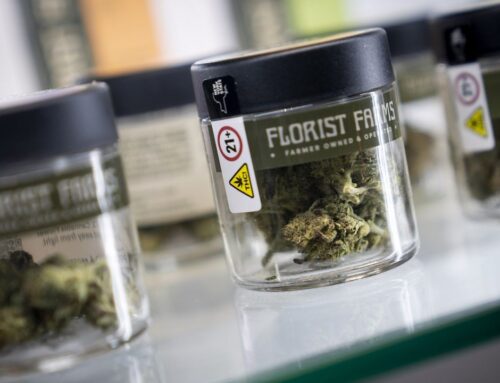Synthetic Turf Proposed for CVU Leads to Environmental Concerns
November 26, 2025
Eli Lesser-Goldsmith strode across a soggy grass athletic field at Champlain Valley Union High School in Hinesburg this month searching for a muddy spot. It had rained the previous day, and Lesser-Goldsmith wanted to find a particularly squishy patch of grass to highlight the problem he and his supporters hope to solve.
“We have some of the best sports teams in the state of Vermont,” Lesser-Goldsmith said as he bounced on the sodden sod. “We have a rich history of high levels of performance and championships, and yet we have a field that on this day is unplayable.”
Lesser-Goldsmith, 48, a Charlotte resident, father of three young children, and co-owner and CEO of Healthy Living markets, is leading a drive to replace one of CVU’s grass fields. The synthetic version he favors would, he says, vastly increase the amount of time kids could play on it. When paired with bright lights for night games and new bleachers to give fans a better view of the action, the $5.5 million project would create a true gathering space for the community, he said.
“The world needs connection right now, and sports is an incredible way to bring people together,” he said. “It brings joy. It brings camaraderie. It brings cheering and happiness and endorphins and all sorts of great things human beings need.”
It also — in the case of artificial turf — brings controversy, and on a scale that Lesser-Goldsmith hadn’t anticipated. CVU voters have twice rejected bond issues to help pay for a new field, but he figured he could overcome most opposition with his pledge to raise the entire cost privately.
“The world needs connection right now, and sports is an incredible way to bring people together.”
Eli Lesser-Goldsmith
It hasn’t quite panned out that way. A small but vocal group of residents has raised a raft of environmental, financial, legal and health concerns about the project. Opponents also suspect it could run afoul of a new state law meant to eliminate the chemicals from a variety of consumer goods, which would derail the proposal.
Lesser-Goldsmith, a lifelong sports fan, is undeterred. He said he’s attended high school games on turf fields across Chittenden County. CVU’s high-quality sports programs merit better facilities, he said.
“I was like, Wow. The biggest high school in Vermont has one of the worst facilities in Vermont. I wonder why?” Lesser-Goldsmith said.
CVU fields drain poorly after it rains, he said, so games are regularly canceled, and its soccer, lacrosse, Ultimate Frisbee and field hockey players must travel to other communities, including the turf fields at South Burlington and Burlington high schools, to compete.

Champlain Valley School District superintendent Adam Bunting, who supports Lesser-Goldsmith’s vision, noted that wet weather in the spring and late fall has always made it challenging to maintain grass athletic fields in Vermont. It’s been particularly difficult for CVU, largely because its fields are atop clay soils that don’t readily absorb rain. The field in question is only playable about 50 percent of the time in the fall, according to a district spokesperson.
“It’s hard not to talk about turf in that context,” Bunting said.
But in articles in local papers, letters to the editor and posts on community forums, critics have raised questions about the wisdom of replacing a mat of living grass with what amounts to a massive plastic carpet.
“The artificial turf idea is dangerous, and legally futile,” Jennifer Decker, a member of the Hinesburg Planning Commission, wrote in an opinion piece in the Shelburne News, noting that she was speaking only for herself. “Let us enjoy spectator sports while preserving democracy, human health and the ecosystem.”
Decker told Seven Days that she is concerned primarily because CVU is located not far from a town well, in a zone where activities that could contaminate town water supplies are restricted.
“I really want to protect my community from the devastating impacts of forever chemicals,” she said.
When the Hinesburg Conservation Commission got wind of Lesser-Goldsmith’s plan, it sent a letter to the Champlain Valley School District Board — which represents Williston, St. George, Shelburne and Charlotte as well Hinesburg — urging it to abandon the idea.
“It is widely known and well-documented that artificial turf contains PFAS, as well as microplastics and numerous other chemicals that are hazardous to human health and the environment,” the commissioners wrote.
PFAS refers to a class of thousands of synthetic chemicals that have been used in consumer goods since the 1950s, often as coatings. The chemical bonds between carbon and fluorine atoms in PFAS compounds are so strong that they don’t break down in the environment, earning them the moniker “forever chemicals.”
A growing body of science links chemicals historically found in synthetic turf to environmental contamination and human health concerns.
The multibillion-dollar synthetic turf industry has experienced rapid growth in recent years as communities facing intense competition for sports fields have turned to turf to maximize playing time. That growth has stoked a national debate reflected in the dispute in Hinesburg.
“I think if there was a vote, it’d be an uphill battle to get it to pass.
Rep. Phil Pouech
State Rep. Phil Pouech (D-Hinesburg) said his town is particularly sensitive to PFAS contamination because a closed 38-acre landfill leached the “insidious” chemicals into surrounding wells. While the donors to the new field are clearly well intentioned, Pouech said, public sentiment doesn’t appear to be on their side.
“I think if there was a vote, it’d be an uphill battle to get it to pass,” Pouech said.
The proposal is unlikely to face a public referendum but will be decided by the school board. The Conservation Commission has argued for greater transparency as the board considers the project in the new year.
“We believe that all environmental, health, and financial liability risks must be fully discussed at public meetings with the CVU community, Hinesburg residents and town officials,” the group wrote in its October 21 letter.
That’s exactly what Bunting says the school board plans to do, probably with a community forum this spring. Building fields that kids can use is important, he said, but the last thing he wants is to divide the community.
“It’s important to me that we walk through this process with respect on all sides and that everyone feels heard,” Bunting said. “That may be naïve, but I think it’s important.”
Lesser-Goldsmith said private fundraising efforts have been quietly under way for a couple of years. He declined to say how much he has raised to date or from whom. After finding “overwhelming” support among the donor and school communities, he assembled a project team that includes Wagner Hodgson Landscape Architecture, Engineering Ventures, ReArch Construction and FieldTurf.
In late October, he unveiled the plans in a press release that included glowing quotes from supporters, including Bunting, and detailed renderings of the proposed renovations.
They showed “Field B,” currently a grass field with a couple of movable soccer goals, transformed into a modern arena with bright lights, new bleachers and the school’s Redhawks logo emblazoned on the center of the artificial turf.
Lesser-Goldsmith said his goal is to match the artificial turf fields at the half a dozen other Vermont high schools that have them.
“We’re not looking to be above and beyond,” he said. “We want a turf field because a turf field is the standard of other varsity high school sports facilities in Vermont.”

When it comes to PFAS, however, there are new standards that such fields will have to meet come January 1. In 2024, Vermont lawmakers banned the sale of certain products, including artificial turf, that contain PFAS. They did so after learning that PFAS contamination was not only a national problem but also a local one.
Beginning in 2017, hundreds of wells in the Bennington area were found to have been contaminated by the chemicals from a factory, ChemFab, that for years had baked Teflon coating onto fabrics. In 2019, the owner of the long-closed plant agreed to pay up to $25 million to connect affected homes to city water. PFAS-laced firefighting foam previously used by the Vermont Air National Guard has contaminated the groundwater around Patrick Leahy Burlington International Airport.
The new law says companies shall not “manufacture, sell, offer for sale, distribute for sale, or distribute for use in this State artificial turf to which PFAS have been intentionally added in any amount.” It also applies when “PFAS have entered the product from the manufacturing or processing of that product, the addition of which is known or reasonably ascertainable by the manufacturer.”
This is where things get complicated. Lesser-Goldsmith asserted that Montréal-based FieldTurf’s faux-grass product is “PFAS-free” and will meet relevant environmental regulations. An official for FieldTurf told Seven Days that “almost no one can legitimately claim a product is “PFAS-free” but that its turf for the CVU field will conform with the new law.
It’s unclear how the company would be able to provide artificial turf with no PFAS when its own studies show trace amounts of the chemicals. In July, FieldTurf released the results of a study it claimed found “no detectable PFAS above state and EPA soil screening levels,” though the tests did detect two chemicals that are PFAS, at 0.28 parts per billion and 0.12 parts per billion.
Kyla Bennett, director of science policy for Public Employees for Environmental Responsibility in Massachusetts, said the proposed CVU field should be held to Vermont’s tougher standard for PFAS contamination in water, not soil, and measured in parts per trillion, not billion. That would make the FieldTurf tests “pretty meaningless,” she said.
The fact that FieldTurf now uses some natural materials, such as cork, as fill is a step in the right direction, Bennett said. But because the blades of “grass” and field backing continue to be made out of plastic, a host of environmental and health concerns remain.
“There are so many problems with this stuff; it’s just smoke and mirrors,” she said.
Bennett, who testified before Vermont lawmakers working on the PFAS bill, worries that the language in the law about “intentionally added” PFAS provides a “loophole for industry.” PFAS materials are often used as lubricants in the manufacturing process, and she worries that this language might allow companies wiggle room with regulators.
The regulator in this case is the state attorney general, who is empowered to go after companies that sell products that violate consumer protection laws. Attorney General Charity Clark said the law gives her office the power to investigate manufacturing processes and impose penalties if needed.
“I think [Act 131] provides the attorney general with the tools she needs to make sure that these products are safe here in Vermont,” Clark told Seven Days.
The AG has wide discretion under the Consumer Protection Act to force manufacturers to remove unsafe products from the market. The office can request manufacturers covered by the law to certify that their products comply. If an investigation determines the manufacturer broke the law, fines and restitution are possible.
While his design team is still working out what permits and approvals the turf field would need, Lesser-Goldsmith said nothing he’s heard from opponents makes him doubt the project’s viability.
“My mantra throughout this has been, I’m going to keep going with this project until the universe tells me it can’t happen,” he said, “and I’ve never heard that once.”
The original print version of this article was headlined “Turf Wars | A proposal to install artificial grass on a CVU playing field spurs worries about ‘forever chemicals’”
This article appears in Nov 26 – Dec 2 2025.
Search
RECENT PRESS RELEASES
Related Post




